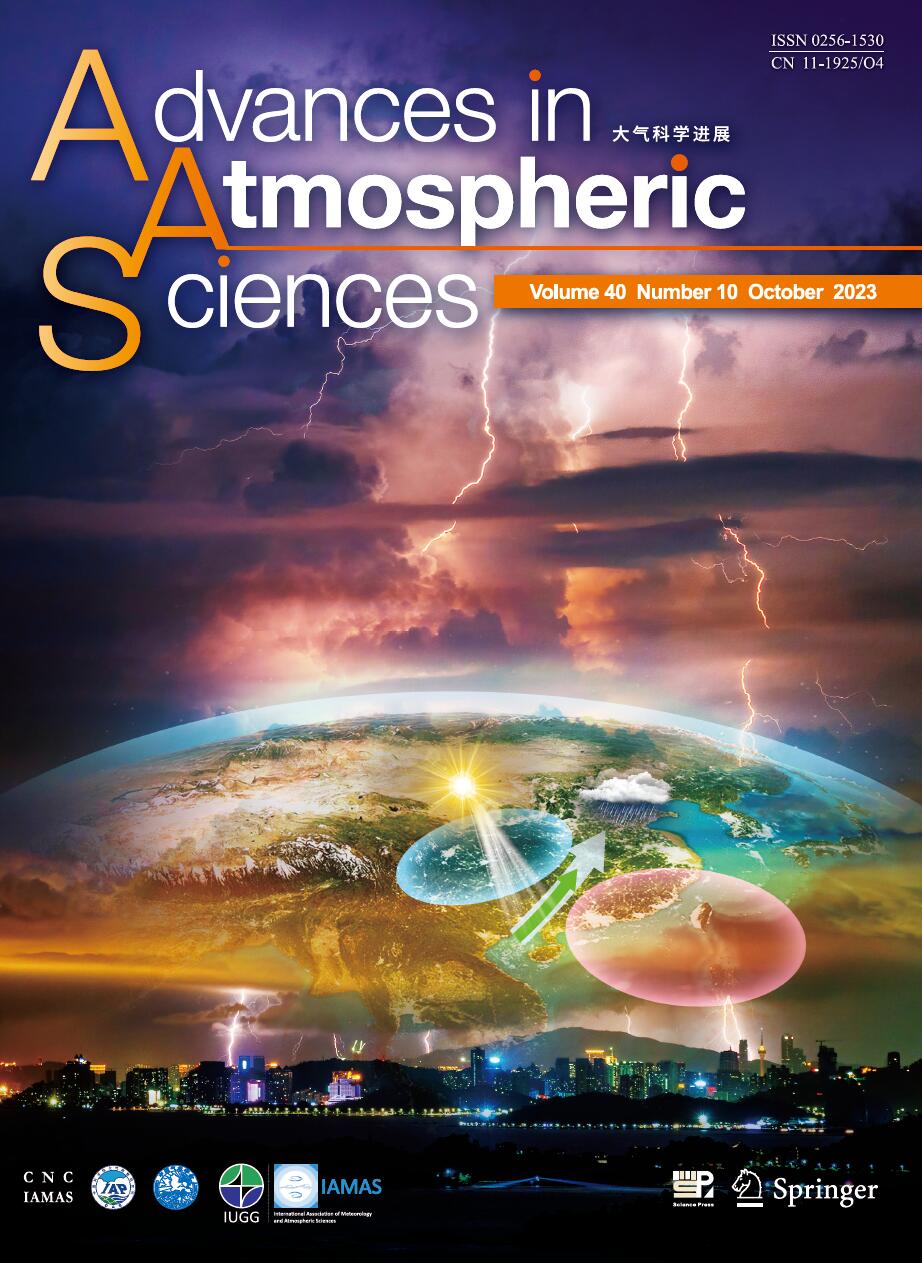| [1] |
Chuan GAO, Xinrong WU, Rong-Hua ZHANG,
2016: Testing a Four-Dimensional Variational Data Assimilation Method Using an Improved Intermediate Coupled Model for ENSO Analysis and Prediction, ADVANCES IN ATMOSPHERIC SCIENCES, 33, 875-888.
doi: 10.1007/s00376-016-5249-1
|
| [2] |
Bin MU, Juhui REN, Shijin YUAN, Rong-Hua ZHANG, Lei CHEN, Chuan GAO,
2019: The Optimal Precursors for ENSO Events Depicted Using the Gradient-definition-based Method in an Intermediate Coupled Model, ADVANCES IN ATMOSPHERIC SCIENCES, 36, 1381-1392.
doi: 10.1007/s00376-019-9040-y
|
| [3] |
Chuan GAO, Rong-Hua ZHANG, Xinrong WU, Jichang SUN,
2018: Idealized Experiments for Optimizing Model Parameters Using a 4D-Variational Method in an Intermediate Coupled Model of ENSO, ADVANCES IN ATMOSPHERIC SCIENCES, 35, 410-422.
doi: 10.1007/s00376-017-7109-z
|
| [4] |
Daquan ZHANG, Lijuan CHEN, Gill M. MARTIN, Zongjian KE,
2023: Seasonal Prediction Skill and Biases in GloSea5 Relating to the East Asia Winter Monsoon, ADVANCES IN ATMOSPHERIC SCIENCES, 40, 2013-2028.
doi: 10.1007/s00376-023-2258-8
|
| [5] |
Fei ZHENG, Jin-Yi YU,
2017: Contrasting the Skills and Biases of Deterministic Predictions for the Two Types of El Niño, ADVANCES IN ATMOSPHERIC SCIENCES, 34, 1395-1403.
doi: 10.1007/s00376-017-6324-y
|
| [6] |
ZHENG Fei, ZHU Jiang, WANG Hui, Rong-Hua ZHANG,
2009: Ensemble Hindcasts of ENSO Events over the Past 120 Years Using a Large Number of Ensembles, ADVANCES IN ATMOSPHERIC SCIENCES, 26, 359-372.
doi: 10.1007/s00376-009-0359-7
|
| [7] |
KANG Xianbiao, HUANG Ronghui, WANG Zhanggui, ZHANG Rong-Hua,
2014: Sensitivity of ENSO Variability to Pacific Freshwater Flux Adjustment in the Community Earth System Model, ADVANCES IN ATMOSPHERIC SCIENCES, 31, 1009-1021.
doi: 10.1007/s00376-014-3232-2
|
| [8] |
Se-Hwan YANG, LI Chaofan, and LU Riyu,
2014: Predictability of Winter Rainfall in South China as Demonstrated by the Coupled Models of ENSEMBLES, ADVANCES IN ATMOSPHERIC SCIENCES, 31, 779-786.
doi: 10.1007/s00376-013-3172-2
|
| [9] |
Yawen DUAN, Peili WU, Xiaolong CHEN, Zhuguo MA,
2018: Assessing Global Warming Induced Changes in Summer Rainfall Variability over Eastern China Using the Latest Hadley Centre Climate Model HadGEM3-GC2, ADVANCES IN ATMOSPHERIC SCIENCES, 35, 1077-1093.
doi: 10.1007/s00376-018-7264-x
|
| [10] |
DING Yihui, LIU Yiming, SHI Xueli, LI Qingquan, LI Qiaoping, LIU Yan,
2006: Multi-Year Simulations and Experimental Seasonal Predictions for Rainy Seasons inChina byUsing a Nested Regional ClimateModel (RegCM NCC) Part II: The Experimental Seasonal Prediction, ADVANCES IN ATMOSPHERIC SCIENCES, 23, 487-503.
doi: 10.1007/s00376-006-0323-8
|
| [11] |
WANG Zhiren, WU Dexing, CHEN Xue'en, QIAO Ran,
2013: ENSO Indices and Analyses, ADVANCES IN ATMOSPHERIC SCIENCES, 30, 1491-1506.
doi: 10.1007/s00376-012-2238-x
|
| [12] |
Xinyi XING, Xianghui FANG, Da PANG, Chaopeng JI,
2024: Seasonal Variation of the Sea Surface Temperature Growth Rate of ENSO, ADVANCES IN ATMOSPHERIC SCIENCES, 41, 465-477.
doi: 10.1007/s00376-023-3005-x
|
| [13] |
Zhou Tianjun, Yu Rucong, Li Zhaoxin,
2002: ENSO-Dependent and ENSO-Independent Variability over the Mid-Latitude North Pacific: Observation and Air-Sea Coupled Model Simulation, ADVANCES IN ATMOSPHERIC SCIENCES, 19, 1127-1147.
doi: 10.1007/s00376-002-0070-4
|
| [14] |
LI Gang*, LI Chongyin, TAN Yanke, and BAI Tao,
2014: The Interdecadal Changes of South Pacific Sea Surface Temperature in the Mid-1990s and Their Connections with ENSO, ADVANCES IN ATMOSPHERIC SCIENCES, 31, 66-84.
doi: 10.1007/s00376-013-2280-3
|
| [15] |
Xiaofei WU, Jiangyu MAO,
2019: Decadal Changes in Interannual Dependence of the Bay of Bengal Summer Monsoon Onset on ENSO Modulated by the Pacific Decadal Oscillation, ADVANCES IN ATMOSPHERIC SCIENCES, 36, 1404-1416.
doi: 10.1007/s00376-019-9043-8
|
| [16] |
Yuanhai FU, Zhongda LIN, Tao WANG,
2021: Simulated Relationship between Wintertime ENSO and East Asian Summer Rainfall: From CMIP3 to CMIP6, ADVANCES IN ATMOSPHERIC SCIENCES, 38, 221-236.
doi: 10.1007/s00376-020-0147-y
|
| [17] |
Yadi LI, Xichen LI, Juan FENG, Yi ZHOU, Wenzhu WANG, Yurong HOU,
2024: Uncertainties of ENSO-related Regional Hadley Circulation Anomalies within Eight Reanalysis Datasets, ADVANCES IN ATMOSPHERIC SCIENCES, 41, 115-140.
doi: 10.1007/s00376-023-3047-0
|
| [18] |
Jingrui YAN, Wenjun ZHANG, Suqiong HU, Feng JIANG,
2024: Different ENSO Impacts on Eastern China Precipitation Patterns in Early and Late Winter Associated with Seasonally-Varying Kuroshio Anticyclonic Anomalies, ADVANCES IN ATMOSPHERIC SCIENCES.
doi: 10.1007/s00376-023-3196-1
|
| [19] |
Junchen YAO, Xiangwen LIU, Tongwen WU, Jinghui YAN, Qiaoping LI, Weihua JIE,
2023: Progress of MJO Prediction at CMA from Phase I to Phase II of the Sub-Seasonal to Seasonal Prediction Project, ADVANCES IN ATMOSPHERIC SCIENCES, 40, 1799-1815.
doi: 10.1007/s00376-023-2351-z
|
| [20] |
Yu NIE, Jie WU, Jinqing ZUO, Hong-Li REN, Adam A. SCAIFE, Nick DUNSTONE, Steven C. HARDIMAN,
2023: Subseasonal Prediction of Early-summer Northeast Asian Cut-off Lows by BCC-CSM2-HR and GloSea5, ADVANCES IN ATMOSPHERIC SCIENCES, 40, 2127-2134.
doi: 10.1007/s00376-022-2197-9
|















 AAS Website
AAS Website 
 AAS WeChat
AAS WeChat 
 DownLoad:
DownLoad: